Challenges in Implementing Environmental Laws and Policies in India
1
Educational Planning, Research and Assessment,
District Institute of Education and Training,
Ansari Road,
Daryaganj,
New Delhi
India
Corresponding author Email: drssponia@gmail.com
DOI: http://dx.doi.org/10.12944/CWE.18.3.27
Copy the following to cite this article:
Sundar S. Challenges in Implementing Environmental Laws and Policies in India. Curr World Environ 2023;18(3). DOI:http://dx.doi.org/10.12944/CWE.18.3.27
Copy the following to cite this URL:
Sundar S. Challenges in Implementing Environmental Laws and Policies in India. Curr World Environ 2023;18(3).
Download article (pdf)
Citation Manager
Publish History
Select type of program for download
| Endnote EndNote format (Mac & Win) | |
| Reference Manager Ris format (Win only) | |
| Procite Ris format (Win only) | |
| Medlars Format | |
| RefWorks Format RefWorks format (Mac & Win) | |
| BibTex Format BibTex format (Mac & Win) |
Article Publishing History
| Received: | 2023-07-20 |
|---|---|
| Accepted: | 2023-12-18 |
| Reviewed by: | 
 Subir Kumar Roy
Subir Kumar Roy
|
| Second Review by: |

 Chadetrik Rout
Chadetrik Rout
|
| Final Approval by: | Dr. R K Aggarwal |
Introduction
Environmental protection now falls under fundamental law in India. Every person's right to live in a pollution-free environment is safeguarded under the Indian constitution. Even if they are sound, it may need much labour to execute and enforce rules and regulations. The sustainability of the Earth is in danger due to the irresponsible use of the environment by humans. Hence, environmental preservation is essential. Because of this, every country makes laws and regulations in addition to guidelines to preserve their unique national settings. In dia's ecological policies encompass a range of laws and results to make the environment sustainable for future generations (Bhuvaneshwari et al., 2019).1 Article 51-A requires everyone to preserve and enhance the environment's many natural resources, such as lakes, rivers, woods, and wildlife. It is also necessary to consider all living organisms in the natural environment. India is already facing issues related to the environment due to different issues in managing resources. The rough use of natural resources and non-renewable resources is creating an impact on future energy resources. As per the points of Malav et al. (2020)2, the policies related to the Nature Conservation Act are not being followed by the people and therefore, issues are being created. According to a survey, the most crucial issue is air pollution, which has been mentioned by 50 percent of the people.
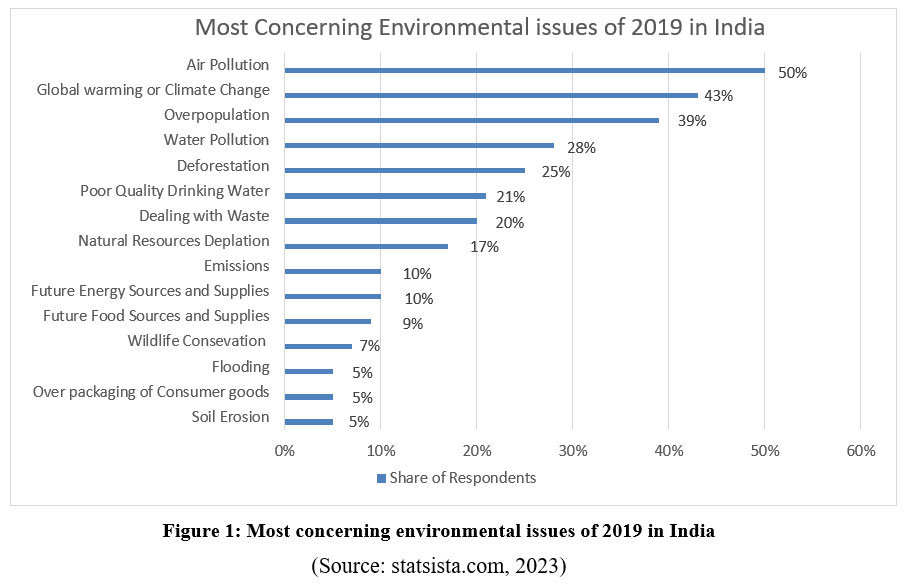 | Figure 1: Most concerning environmental issues of 2019 in India.
|
(Source: statsista.com, 2023)
Global warming and the issue related to climate change and its third impact are seen by 48% of the people. Overpopulation and their use of resources are also significant issues that have been mentioned by 39% of the people (statista.com, 2023)3. Matters related to deforestation, issues of drinking water, manageable wastage products, and flooding issues are also being found as issues in nature. It is true that some people might not be as concerned about the future consequences that could affect the environment and their sustainability. There could be a number of reasons for this, including ignorance, the need to attend to urgent matters first, or the conviction that small actions won't make a big difference.
It's crucial to remember, though, that there are a large number of people, groups, and communities throughout the world who have a solid commitment to sustainability and are actively trying to lessen the effects of climate change and other environmental problems. They are aware that the decisions we make now could have a significant effect on the planet in the future. These are creating a significant impact on nature, and therefore, citizens must strictly follow policies to ensure a sustainable life for the future and the next generation. The main objective of the research is to identify the different issues that have come up in India as a result of the application of environmental laws and regulations.
The research's objectives include
RO1: To know the importance of different environmental laws and policies that the Indian Government makes to conserve nature.
RO2: To find the challenges faced in India in maintaining and regulating the rules and issues related to environmental policies.
RO3: To find the negative impact of the challenges facing implementing the rules and regulations related to the environment in India.
RO4: To make strategies that may help mitigate the issues and challenges faced when implementing the rules and regulations of the environment in India.
The questions of this research are stated below
RQ1: What is the importance of different environmental laws and policies made by the Indian Government for conserving nature?
RQ2: What are the challenges faced in India in maintaining and regulating the rules and issues related to the environment?
RQ3: What are the negative impacts of the challenges facing implementing the rules and regulations related to the environment in India?
RQ4: What strategies may help mitigate the issues and challenges faced when implementing the rules and regulations of the environment in India?
The hypothesis of the research is
H1: There are many challenges to implementing different environmental laws and programmes in India.
H0: There is no challenge to implementing different environmental laws and programmes in India.
Environmental laws and regulations in India are too strong, but there is very little obedience from the people. A court handles and deals with different types of environmental cases. As per the Environmental Performance Index, India is high in pollution globally (Sharma et al., 2020)4. Different types of laws related to the environment face different types of challenges to implementation. As per the rapid and high industrialisation, increment in population with high index, deforestation, lack of knowledge and education among the people about the environment, it is being faced with issues for implementing the rules of the environment. Therefore, natural resources have been decreasing at a terrifying rate, creating a significant issue.
One of the main reasons for implementing the rules is related to the environment. Due to excessive interference of the Government, no power to work freely is also a reason for facing issues with the implementation of the environmental rules. Lack of awareness among people and education about laws and increasing demand for industrialisation are the main reasons for facing issues in implementing environmental policies in India (Zhang et al., 2020)5.
This study will focus on the issues that are faced with the implementation of environmental laws in India. This research will be helpful to know the issues and, as per the issues, strategies should be taken by the people in a significant way. Therefore, the issues for implementation of environmental laws will be helpful.
Literature review
Importance of different environmental laws and policies
 | Figure 2: Importance of conservation of natural resources.
|
(Source: Gupta, Soni & Kumar2019)
Environmental laws and policies are made to maintain air, water, forests, and other natural resources. Humans depend on natural resources to sustain their lives; however, using them carelessly endangers their lives. As per the insights of Gupta, Soni, and Kumar (2019)6, negligence of rules and policies to maintain the balance of natural resources may create outstanding issues for people. On the other hand, disobeying the rules, laws, and policies related to the environment may cause punishments like fines and jail time (Farooq et al., 2019)7. Environmental laws and policies are the only treatment steps for people using the environment poorly.
The challenges of putting India's environmental rules and policies into practice
The main challenge faced when implementing the environmental laws in India is related to poor coordination among the Government agencies. As per the views of Manda & Ben Dhaou (2019)8, the capacity of the institutions is also poor, and their instruments, technologies, and arrangements are also not managed by the government.
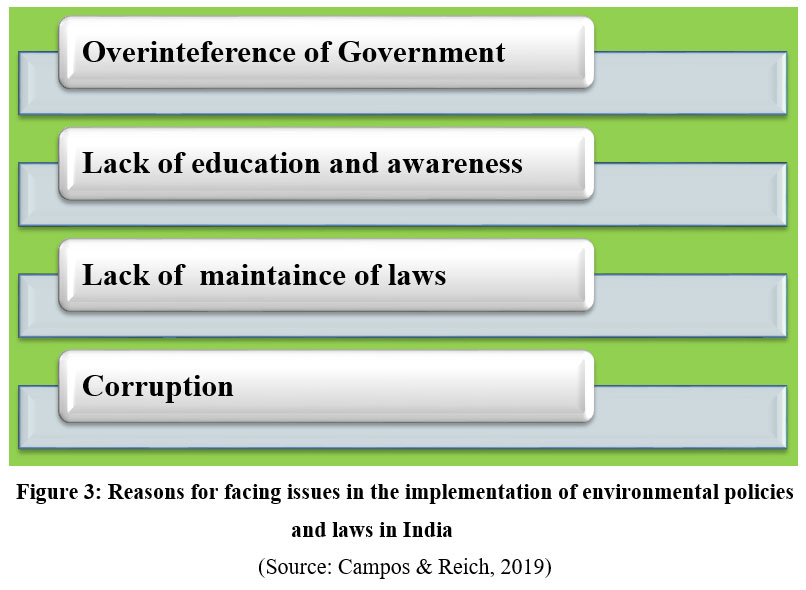 | Figure 3: Reasons for facing issues in the implementation of environmental policies and laws in India.
|
(Source: Campos & Reich, 2019)
Corruption among the high designation ministers is also an issue. Industrialists are not maintaining the rules for their business, and they are not getting punished for violating environmental laws. On the other hand, it can be said critically that lack of awareness and education among people and the demand for money are also creating issues for implementing laws (Campos & Reich, 2019)9. People are not thinking about the near future; they are only thinking about the present. The main issues in India are the lack of money and not being afraid or lack of education to know what is waiting in the future.
The negative impact of the challenges for the implementation of environmental laws
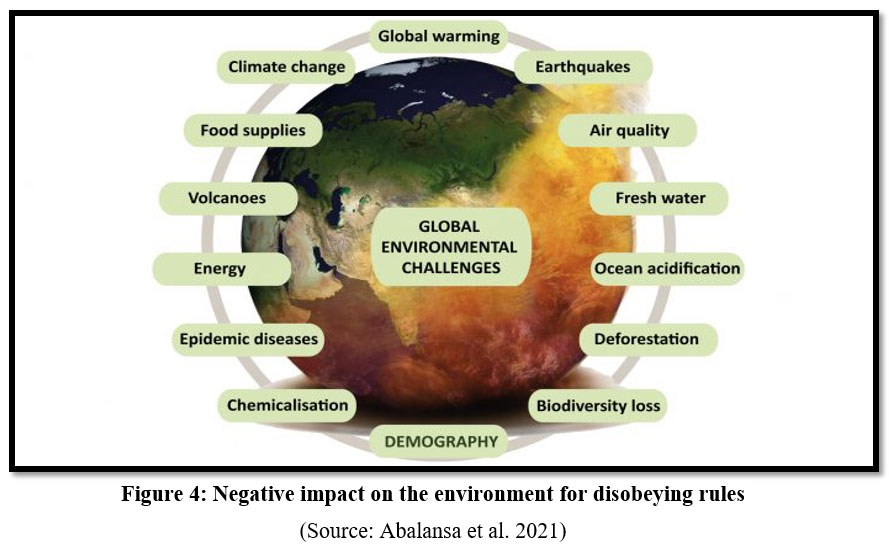 | Figure 4: Negative impact on the environment for disobeying rules.
|
(Source: Abalansa et al. 2021)
As issues with implementing environmental policies are faced, a list of issues is being created in India. The most critical issue that is being created is air pollution, and it has been seen that India is the third largest country, contributing 2.65 billion metric tons of carbon into the air. As per the views of Abalansa et al. (2021)10, around the earth, air and water have been polluted to such a level that 70% of the surface-level water is unfit for consumption. The weather balance has also been devised. Too much heat in summer and too much rain in no time also creates issues. There are heat waves and issues in many places. Floods have also been faced several times due to deforestation and the cutting of trees. The agricultural lands are facing droughts, and these are only because of not obeying rules and environmental policies (fortunejournals.com, 2023.)11.
Strategies may help mitigate the laws and rules or policies related to the environment.
The government should be stricter, and there should not be any corruption to allow for the immediacy of rules. As per the insights, the government should take steps that violate the environment's rules and policies. People should be provided with more environmental education so they can also participate in this mission (earth.org, 2023)12. Workshops and programs should be done to make people more aware of the future of the next generation. People should understand the root causes of natural devastation. On the other hand, people should be supportive of managing the issues, and industrialists must decrease their lust for money, which is the leading cause of all types of pollution (Bhuvaneshwari et al., 2019)13.
Pollution control boards should be stricter to manage the total situation properly. Maintenance of rules and regulations and punishment for the people violating the rules may help implement the environmental rules. Schools and colleges should provide proper education to help students become more aware of nature (Sharma & Das, 2020)14. Rewards and benefits should be given with the help of NGOs. Ultimately, the tree plantation program should be done at any cost and introduced into the people's ordinary lives.
Theoretical framework
Norm Activation Model
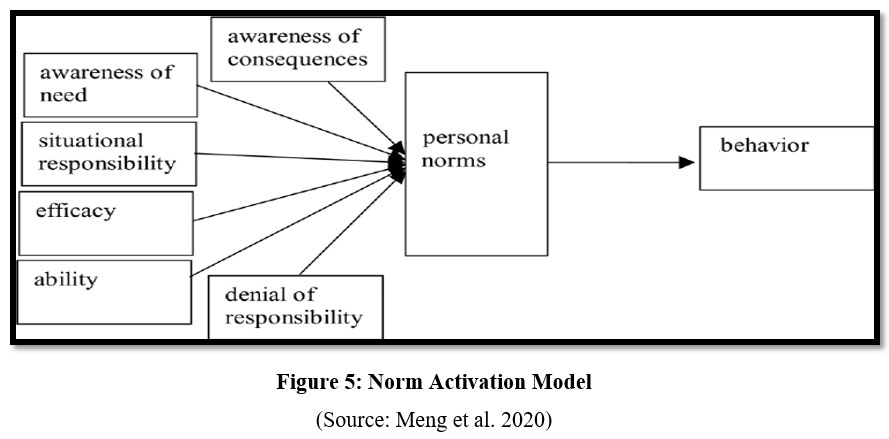 | Figure 5: Norm Activation Model.
|
(Source: Meng et al. 2020)
“The Norm Activation Model” was derived by Schwartz (1977)15 and was helpful for the identification of the drivers that may influence the human intention for nature. It can be defined as social behaviour that can create an impact on others. Personal behaviour has a great help in reducing the destructive performance and effects on the natural system that is shared in multiple shares of behaviours (Meng et al., 2020)16. With the help of this model, people should become softer with the environment, which should help make the planet more sustainable.
Theory of Environmentally Response Behaviour
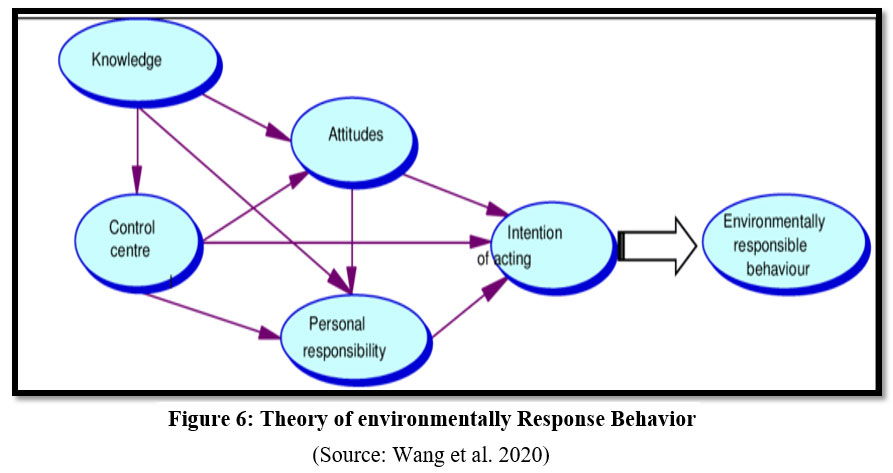 | Figure 6: Theory of environmentally Response Behavior
|
(Source: Wang et al. 2020)
The authors of the ERB theory are Hines, Tomera, and Hungerford (1987).17. As per this theory, one cannot take responsibility for the environment. It is the total work of the people to maintain the environment. Knowledge of the rules and regulations of the environment can help others to know about them. Being influenced by their act, some others may be desired to act as this may help to implement the laws and results related to the environment (Wang et al., 2020)18.
Methodology
In the methodology, the primary quantitative research method is used with the help of fifty-five surveys to get unbiased results. The positivist philosophy of the resource has been used in the present research to get the scientific analysis of collected data. On the other hand, the challenges faced by the people in implementing the challenges at the time of environmental rules in India are asked of different officers, people, and agencies related to environmental conservation (Villanthenkodath & Mahalik, 2022)19. The deductive research approach was employed in this study, relying on theoretical frameworks that have significant connections to this resource. This approach can help test the knowledge of the policies that are gathered to conclude. It is also helpful to mitigate the gaps in the research that have been faced before. Some hypotheses have to be proved at the end of this research, the hypotheses are tested, and at the end of this research, the results are collected, and questions are made. A descriptive research design helps understand the phenomena that are useful for the study of the whole research (Bhuvaneshwari et al., 2019)20.
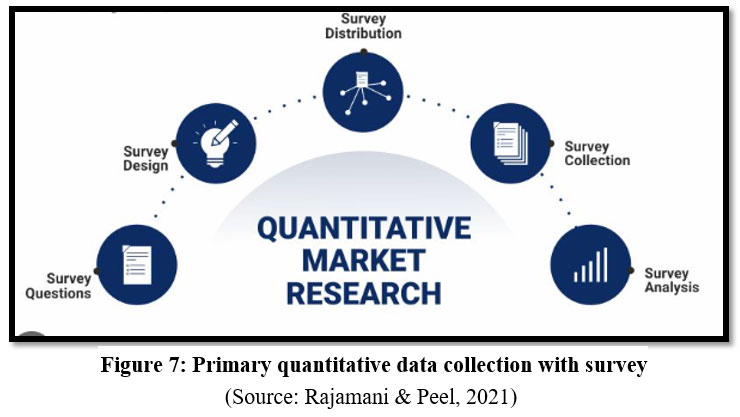 | Figure 7: Primary quantitative data collection with survey
|
(Source: Rajamani & Peel, 2021)
The primary data collection method is followed to gather general data from people. Primary data is collected from the non-existence of sources that cannot be manipulated. These thirteen questions were asked to the officers, people and the agencies' departments related to India's environmental policies. In this study, SPSS was done with data collected from different people. This present analysis includes frequency analysis and linear regression analysis, including the model summary analysis, ANOVA test, and coefficient test. The Pearson correlation test is an excellent help in providing information about the relationship between different variables needed for this research.
During the whole research process, the researchers maintained the process of the stretch needed for the research. No people were forced to give their opinion for this survey (Rajamani & Peel, 2021)21. There was no manipulation done to make their opinion biased. This was done to maintain the unbiasedness of the data. The secondary data resources used for this research are appropriately cited. The verification of the secondary data resources has not been done. The secondary data were gathered from various books, newspapers, journals, and articles on Google Scholar. All the authors’ copyrights are conserved in this study.
Finding and analysis
Demographic Analysis
Age
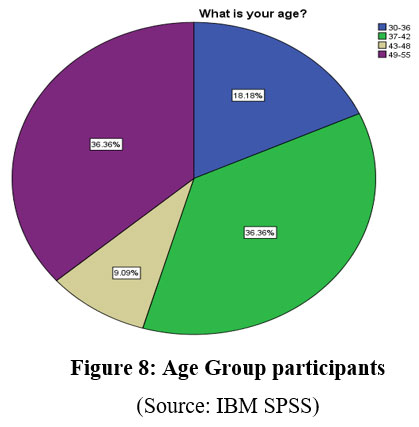 | Figure 8: Age Group participants.
|
(Source: IBM SPSS)
What is your Age?
Table 1: Age of Participants
Valid | Freq. | % | Valid % | Cumulative % |
30-36 37-42 43-48 49-55 Total | 10 20 5 20 55 | 18.2 36.4 9.1 36.4 100.0 | 18.2 36.4 9.1 36.4 100.0 | 18.2 54.5 63.6 100.0 |
Source: IBM SPSS)
The respondents to the survey belonged to different age groups. The total respondents have been divided into four distinct age groups. The respondents between the ages of 30 and 36 were 18.2%, and The age categories of 49 to 55 and 37 to 42 accounted for the largest percentage of responders (36.4%). Of the responders, just 9.1% were between the ages of 43 and 48. The respondents of different age groups helped to determine the most influential factors that impacted the research topic. The experiences of the different age groups vary, and they answered the survey questions based on their knowledge.
Gender
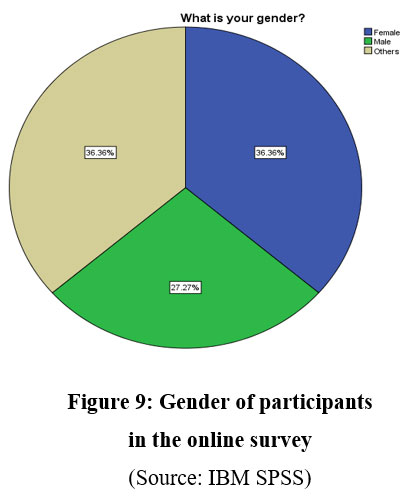 | Figure 9: Gender of participants in the online survey.
|
(Source: IBM SPSS)
What is your Gender?
Table 2: Gender of participants.
Valid | Freq. | % | Valid % | Cumulative % |
Female Male Others Total | 20 15 20 55 | 36.4 27.3 36.4 100.0 | 36.4 27.3 36.4 100.0 | 36.4 63.6 100.0 |
(Source: IBM SPSS)
Respondents were from different genders, and all were interested in joining in the survey processes. Female and other respondents were the maximum, and they were 36.4% each. Males were only 27.3%. This demarcates that the male and female were the survey participants, which helps to get adequate knowledge about the research topic.
Educational qualifications
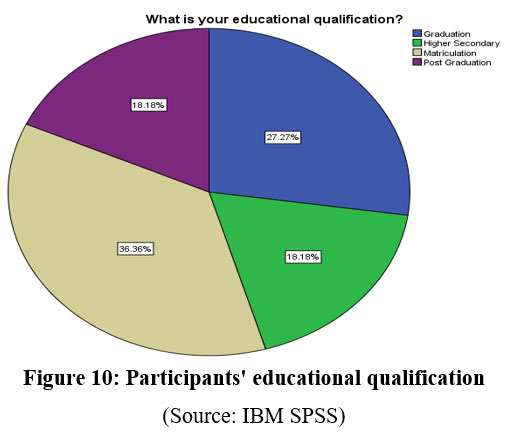 | Figure 10: Participants' educational qualification
|
(Source: IBM SPSS)
What is your educational qualification?
Table 3: Educational Qualification Analysis through Descriptive Analysis.
Valid | Freq. | % | Valid % | Cumulative % |
Graduation Higher Secondary Matriculation Post Graduation Total | 15 10 20 10 55 | 27.27 18.18 36.36 18.18 100.0 | 27.27 18.18 36.36 18.18 100.0 | 27.27 45.45 81.81 100.0 |
(Source: IBM SPSS)
The educational qualification of the respondents represents their academic qualifications and theoretical knowledge. The respondents were from different educational backgrounds; 27.27% were graduates, and higher secondary passed respondents were 18.18%. The percentage of the respondents who passed the matriculation degree was 36.36%, and the postgraduate respondents were 18.18%. The respondents from different educational backgrounds adequately answer all the questions. This increases the realities of the research work as people from different educational strata have different experience levels.
Statistical analysis
Descriptive Analysis
Qualitative Statistics
Table 4: Qualitative analysis of different variables
| N | Range | Minim | Maxm | Mean | Std. Deviation | Skewness | Kurtosis | ||
Stat Figures | Stat Figures | Stat Figures | Stat Figures | Stat Figures | Stat Figures | Stat Figures | Std. Error | Stat Figures | Std. Error | |
Depndent Variable Indpendent Variable 1 Indpendent Variable 2 Indpendent Variable 3 Valid N (List-wise) | 55
55
55
55
55 | 12.00
7.00
6:00
6:00
| 3:00
8:00
4:00
4:00 | 15:00
15:00
10:00
10:00 | 12.1818
13.9091
8.9091
8.8182
| 3.18614
2.12806
1.74561
1.81650 | -2.097
-2.031
-2.024
-1.739 | .322
.322
.322
.322
| 4.154
3.105
3.408
2.167 | .634
.634
.634
.634 |
(Source: IBM SPSS)
Qualitative (Descriptive) analysis of this research helps to compare and correlate the relation between the different IVs and DV. This demarcates the standard error similar for all IVs and DV of the research. This helps to represent the Skewness and Kurtosis analysis report. The impact of various DV and IVs on the research topic is ascertained with the aid of this descriptive analysis.
Hypothesis 1
Table 5: Analysis of Linear Regression
Synopsis of the Model
Model | R | R2 | Adjusted R2 | Standard Error of Approximation | R2 Change | F Change | Df1 | Df2 | Sig. F Change | Durbin-Watson |
1 | .890 | .792 | .788 | 1.46557 | .792 | 202.218 | 1 | 53 | .000 | 1.522
|
ANOVAa
| Model | Sum of Squares | Df | Mean Squares | F | Sig. |
1 Reg-ression Residual Total |
434.344 113.838 548.182 |
1 53 54 |
434.344 2.148 |
202.218 |
.000 |
Coefficients of a
Model
| Unstandardised Coefficients of | Standardised Coefficients of | T | Sig. | |
B | Std. Error | Beta | |||
1 (Constant- Unchangeable) IV1
| -6.355
1.333 | 1.318
.094 |
.890 | -4.820
14.220 | .000
.000 |
(Source: IBM SPSS)
The significant value of the regression analysis of the variables in Hypothesis 1 is displayed in the table above. Given that this indicates a positive link between the variables in this hypothesis, the significance value should be less than 0.005. This hypothesis has a significant value of 0, which is perfect.
Hypothesis 2
Table 6: Analysis of Regressionis for Hypothesis 2
Synopsis of the Modelb
| Model | R | R2 | Adjusted R2 | Standard Error of Approxi-mation | R2 Change | F Change | Deg. Of freedom1 (df1) | Deg. Of freedom2 (Df2) | Sig. F Change | Durbin-Watson |
| 1 | .919 a | .844 | .841 | 1.27041 | .844 | 286.655 | 1 | 53 | .000 | 1.273 |
ANOVA a
| Model | Sum of Squares | Deg. Of freedom(Df) | Mean Squares | F | Sig. |
1 Regression Residual Total | 462.643
85.539 548.182 | 1
53 54 | 462.643
2.148 | 286.655 | .000 |
Coefficients of a
Model
| Unstandardized Coefficients of | Standardized Coefficients of | T | Sig. | |
B | Std. Error | Beta(?) | |||
IV2 | -2.757 1.677 | .899 .099 |
.919 | -3.067 16.931 | .003 .000 |
(Source: IBM SPSS)
The relationship between the variables in this hypothesis is shown in the above table. Understanding the relationship status of the many variables in this hypothesis is made easier with the use of regression analysis. The regression's significance value of 0 indicates that there is a strong correlation between the hypothesis's independent and dependent variables.
Hypothesis 3
Table 7: Analysis of regression for Hypothesis 3
Synopsis of the Modelb
| Model | R | R2 | Adjusted R2 | Standard Error of Approximation | R2 Change | F Change | Df1 | Df2 | Sig. F Change | Durbin-Watson |
| 1 | .870 a | .756 | .752 | 1.58722 | .756 | 164.597 | 1 | 53 | .000 | 2.582 |
ANOVA a
| Model | Sum of Squares | Deg. Of Freedom (Df) | Mean Squares | F | Sig. |
1 Regression Residual Total | 414.661 133.520 548.182 | 1 53 54 | 414.661
2.519 | 164.597 | .000b |
Coefficients of a
Model
| Unstandardized Coefficients of | Standardized Coefficients of | T | Sig. | |
B | Std. Error | Beta | |||
IV3 | -1.270 1.526 | 1.070 .119 |
.870 | -1.187 12.830 | .240 .000 |
(Source: IBM SPSS)
The significant value of this hypothesis, or whether the variables have a positive or negative association, is shown in the above table. This hypothesis's significance value, which is zero, shows that its numerous factors have a significant and positive association with one another. A positive indicator of a positive association is defined as a significant value less than 0.005. This kind of study shows how IV actually affects the research hypothesis's DV.
Pearson Correlation Test
Table 8: Correlation test between a DV and IVs
Dep. Variable | Dep. Variable DV | Indep. Variable IV1 | Indep. Variable IV2 | Indep. Variable IV3 |
The Pearson Coefficient(Correlation) Sig. (2 tailed) N | 1
55 | .890**
.000
55 | .919**
.000 | .870**
.000 |
Dep. Variable The Pearson Coefficient (Correlation) Sig. (2 tailed) N | .890**
.000
55 | 1
55 | .970**
.000 | .954**
.000
55 |
Dep. Variable The Pearson Coefficient (Correlation) Sig. (2 tailed) N | .919
.000
55 | .970**
.000
55 | 1
55 | .958**
.000
55 |
Dep. Variable The Pearson Coefficient (Correlation) Sig. (2 tailed) N | .870**
.000
55 | .954**
.000
55 | .958**
.000
55 | 1
55 |
(Source: IBM SPSS)
The table above of correlation demarcates the relation between all IVs and DV of the research. It represents the correlation value of the IVs and DV for their interrelated relation. The higher correlation value is defined as a good indicator and represents the positive relation among the different variables of this research. Maximum correlation values are near 1, a good sign of the research. Correlation values are essential as they represent the dependency of all the variables on others.
Discussion
The findings confirmed that there are undoubtedly difficulties in implementing laws and regulations in India at various times. As per the literature review, it has been seen that due to the people's lack of education and awareness, the issues are faced at different times for implementing rules and regulations in India's total system. As a result, it has been seen that most of the people in India are not aware of the challenges they may face in the future if they are not rewarded with the environment at this moment. Most people are not interested in the future effects that may affect their sustainability and the planet (Elmagrhi et al., 2019)22.
In addition, it has been seen that corruption has proven to be an excellent tool for implementing the difficulties encountered in putting environmental laws and regulations into effect. Various unethical individuals or law enforcement officials have been uncovered, and they have approved numerous businesses and locations that do not adhere to environmental regulations. This may hamper the environment in the future. In general, it has been observed that Abiding with the laws and policies is a matter of mindset, and this mindset evolves in the education of individuals in the initial years of schooling. Mindset is affected by the behaviours reflected by our elders; several research strengthens this statement that children adopt the behaviours of their elders, Som Tyagi,(2016)23 in lectures on Existential realities or Co-Existential Philosophy. Manipulation and rough use of the industrialists have also been significant reasons for implementing environmental policies and laws (Han, 2021)24. Ultimately, by making more money, the industrialists are not following the rules and regulations necessary to maintain and conserve natural resources like water and forests (Lazarus, 2023)25. They are not giving too much value to the regulations and laws. Another issue is that the government interferes too much with autonomous agencies that want to conserve nature. This also impacts the reformation of nature, which is being affected.
Conclusion
Thus, it can be concluded that many challenges hamper the implementation of environmental policies in India. Lack of awareness about the environment and lack of education among people are the main reasons they affect and create challenges in implementing environmental policy. Most people in India do not have an awareness of the environment. Issues also make challenges, such as the interference of the Government, lack of freedom to do work, and lack of punishment for violation of rules; corruption is also the main challenge responsible for implementing the environmental rules and laws and regulations in India. Overpopulation is another factor affecting the conservation of laws and environmental policies. Overcrowdedness also causes a demand for food supplies and natural resources. People have to use natural resources to meet their demands. During all of this, it is also being seen that the restrictions and the laws are not working as those are not followed by the people. The people are not aware of the planet's sustainability to live long. Lust for industrialisation and the people to make more money in short ways also creates violations of the people's rules. All these causes are the main challenges faced at the time of implementation of the policies and rules in India related to the environment.
Acknowledgement
I want to thank everyone who has supported me in this quest, including the researchers whose research papers were used as a source for the current study and were referenced in the research report.
Conflict of interest
There is no conflict of interest.
Funding Sources
There is no funding sources.
References
- Bhuvaneshwari, S., Hettiarachchi, H., & Meegoda, J. N. (2019). Crop residue burning in India: Policy challenges and potential solutions. International journal of environmental research and public health, 16(5), 832. Retrieved on 14th July 2023 from: https://www.mdpi.com/1660-4601/16/5/832/pdf
CrossRef - Malav, L. C., Yadav, K. K., Gupta, N., Kumar, S., Sharma, G. K., Krishnan, S., ... & Bach, Q. V. (2020). A review on municipal solid waste as a renewable source for waste-to-energy project in India: Current practices, challenges, and future opportunities. Journal of Cleaner Production, 277, 123227. Retrieved on 14th July 2023 from: https://www.academia.edu/download/ 68024473/1_s2.0_S0959652620332728 _main.pdf
CrossRef - statista.com, 2023. Leading environmental issues in India. Retrieved on 14th July 2023 from:https://www.statista.com/statistics/999489/india-leading-environmental-issues/
- Sharma, E., & Das, S. (2020). Measuring impact of Indian ports on environment and effectiveness of remedial measures towards environmental pollution. International Journal of Environment and Waste Management, 25(3), 356-380. Retrieved on 14th July, 2023 from: https://www.academia.edu/download/98078828/ijewm.2020.10629520230201-1-5a1fh9.pdf
CrossRef - Zhang, J., Kang, L., Li, H., Ballesteros-Pérez, P., Skitmore, M., & Zuo, J. (2020). The impact of environmental regulations on urban Green innovation efficiency: The case of Xi'an. Sustainable Cities and Society, 57, 102123. Retrieved on 14th July, 2023 from: https://eprints.qut.edu.au/198127/1/56883013.pdf
CrossRef - Gupta, S., Soni, U., & Kumar, G. (2019). Green supplier selection using multi-criterion decision making under fuzzy environment: A case study in automotive industry. Computers & Industrial Engineering, 136, 663-680. Retrieved on 14th July, 2023 from:https://fardapaper.ir/mohavaha/uploads/2021/06/Fardapaper-Green-supplier-selection-using-multi-criterion-decision-making-under-fuzzy-environment-A-case-study-in-automotive-industry.pdf
CrossRef - Farooq, M. S., Riaz, S., Abid, A., Abid, K., & Naeem, M. A. (2019). A Survey on the Role of IoT in Agriculture for the Implementation of Smart Farming. Ieee Access, 7, 156237-156271. Retrieved on 14th July, 2023 from: https://ieeexplore.ieee.org/iel7/6287639/6514899/08883163.pdf
CrossRef - Manda, M. I., & Ben Dhaou, S. (2019, April). Responding to the challenges and opportunities in the 4th Industrial revolution in developing countries. In Proceedings of the 12th international conference on theory and practice of electronic governance (pp. 244-253).Retrieved on 14th July, 2023 from: http://collections.unu.edu/eserv/UNU:7324/p244-Ickson-Manda.pdf
CrossRef - Campos, P. A., & Reich, M. R. (2019). Political analysis for health policy implementation. Health Systems & Reform, 5(3), 224-235.Retrieved on 14th July, 2023 from: https://www.tandfonline.com/doi/pdf/10.1080/23288604.2019.1625251
CrossRef - Abalansa, S., El Mahrad, B., Icely, J., & Newton, A. (2021). Electronic waste, an environmental problem exported to developing countries: The GOOD, the BAD and the UGLY. Sustainability, 13(9), 5302. Retrieved on 14th July, 2023 from: https://www.mdpi.com/2071-1050/13/9/5302/pdf
CrossRef - fortunejournals.com, 2023. Theories and concepts of human behaviors.Retrieved on 14th July, 2023 from: http://www.fortunejournals.com/articles/theories-and-concepts-for-human-behavior-in-environmental-preservation.html
- earth.org, 2023. Issues related to environments in India. Retrieved on 14th July, 2023 from: https://earth.org/environmental-issues-in-india/
- Bhuvaneshwari, S., Hettiarachchi, H., & Meegoda, J. N. (2019). Crop residue burning in India: policy challenges and potential solutions. International journal of environmental research and public health, 16(5), 832. Retrieved on 14th July, 2023 from: https://www.mdpi.com/1660-4601/16/5/832/pdf
CrossRef - Sharma, M., Joshi, S., Kannan, D., Govindan, K., Singh, R., & Purohit, H. C. (2020). Internet of Things (IoT) adoption barriers of smart cities’ waste management: An Indian context. Journal of Cleaner Production, 270, 122047. Retrieved on 14th July, 2023 from: https://findresearcher.sdu.dk/ws/files/182238225/Accepted_version.pdf
CrossRef - Onwezen, Marleen C. & Antonides, Gerrit & Bartels, Jos, 2013. "The Norm Activation Model: An exploration of the functions of anticipated pride and guilt in pro-environmental behaviour," Journal of Economic Psychology, Elsevier, vol. 39(C), pages 141-153.
CrossRef - Meng, B., Chua, B. L., Ryu, H. B., & Han, H. (2020). Volunteer tourism (VT) traveller behaviour: Merging norm activation model and theory of planned behaviour. Journal of Sustainable Tourism, 28(12), 1947-1969. Retrieved on 14th July, 2023 from: https://www.tandfonline.com/doi/pdf/10.1080/09669582.2020.1778010?casa_token=9wU4aulJjQgAAAAA:ghqbWdvVqjjsBor7 YnTeA2uJ0xigK3HtPFAs1SkgFrij TquW0x5O3fQ2n9e4qOlxo5YtTp-Vd8CLzA
- Hines JM, Hungerford HR, Tomera AN. Analysis and synthesis of research on responsible environmental behaviour: A meta-analysis. The Journal of Environmental Education 18 (1987): 1-8
CrossRef - Wang, Y., Liang, J., Yang, J., Ma, X., Li, X., Wu, J., ... & Feng, Y. (2019). Analysis of the environmental behaviour of farmers for non-point source pollution control and management: An integration of the theory of planned behaviour and the protection motivation theory. Journal of environmental management, 237, 15-23. Retrieved on 14th July, 2023 from: http://img.data.ac.cn/geotest/M00/01/26/n-JvbF6yN5WAX3hrABWkEfvqELU655.pdf
CrossRef - Villanthenkodath, M. A., & Mahalik, M. K. (2022). Technological innovation and environmental quality nexus in India: does inward remittance matter?. Journal of Public Affairs, 22(1), e2291. Retrieved on 14th July, 2023 from: https://www.researchgate.net/profile/Muhammed-Ashiq-Villanthenkodath/publication/343046378_Technological_Innovation_and_Environmental _Quality_Nexus_in_India_Does_Inward_ Remittance_Matter/links/5f4b3af392851c6cfd0076e5/Technological-Innovation-and-Environmental-Quality-Nexus-in-India-Does-Inward-Remittance-Matter.pdf
CrossRef - Bhuvaneshwari, S., Hettiarachchi, H., & Meegoda, J. N. (2019). Crop residue burning in India: policy challenges and potential solutions. International journal of environmental research and public health, 16(5), 832. Retrieved on 14th July, 2023 from: https://www.mdpi.com/1660-4601/16/5/832/pdf
CrossRef - Rajamani, L., & Peel, J. (Eds.). (2021). The Oxford handbook of international environmental law. Oxford University Press. Retrieved on 14th July, 2023 from: https://www.research.ed.ac.uk/files/8186641/the_oxford_handbook.pdf
CrossRef - Elmagrhi, M. H., Ntim, C. G., Elamer, A. A., & Zhang, Q. (2019). A study of environmental policies and regulations, governance structures, and environmental performance: The role of female directors. Business strategy and the environment, 28(1), 206-220. Retrieved on 14th July, 2023 from: https://eprints.soton.ac.uk/425077/1/Accepted_BSE_Manuscript_9_October_2018.pdf
CrossRef - Som Tyagi(2017). Jeevan vidya shivir-A Study of Co-existential Realities- Lecture Series On mindset, thought etc. Retrieved on Dec2, 2023 from: https://youtu.be/wDH0yj1b7e8?si=PmXruu5Aw8wl3_xU
- Han, H. (2021). Consumer behavior and environmental sustainability in tourism and hospitality: A review of theories, concepts, and latest research. Journal of Sustainable Tourism, 29(7), 1021-1042. Retrieved on 14th July, 2023 from: https://www.tandfonline.com/doi/pdf/10.1080/09669582.2021.1903019
CrossRef - Lazarus, R. J. (2023). The making of environmental law. University of Chicago Press. Retrieved on 14th July, 2023 from: https://www.mccain.de/sites/mccain.de/files/contact/the-making-of-environmental-law-richard-j-lazarus-6ca0e28.pdf
Abbreviations
DV- Dependent Variables
IV-IndependentVariables
SPSS- Statistical Package for the Social Sciences
RO- Research Objective
RQ- Research Question
Appendices
Appendix 1: Survey questionnaire
1. What is your age?
30-36
37-42
43-48
49-55
2. Which gender are you?
Male
Female
Others
3. What is your academic qualification?
Matric
Higher Secondary
Graduation
Post Graduation
Dependant variable: Challenges faced in India
4. People are violating the rules of environment policies.
5. Industrialists are not maintain the rules for their business
6. After the application and punishment rules also, people are not showing interest to maintain rules
Independent variable: Reasons for violations of rules
7. The Government is interfering too much in those agencies those are trying to protect the environments policies
8. There is a huge level of corruption among ministries for violation of environmental rules
9. Industrialists are not being punished for violation of rules
Independent variable: Corruption
10. Strict rules and regulations and punishment should be implicated for breaking rules.
11. Higher officers should be strict and should not be involved in corruption to reduce the breaking of rules
Independent variables: Strategies to mitigate the issues
12. Industrialists should maintain the rules strictly related to the environment.
13. Proper education and awareness should be provided to the people with the help of workshops and programs.






